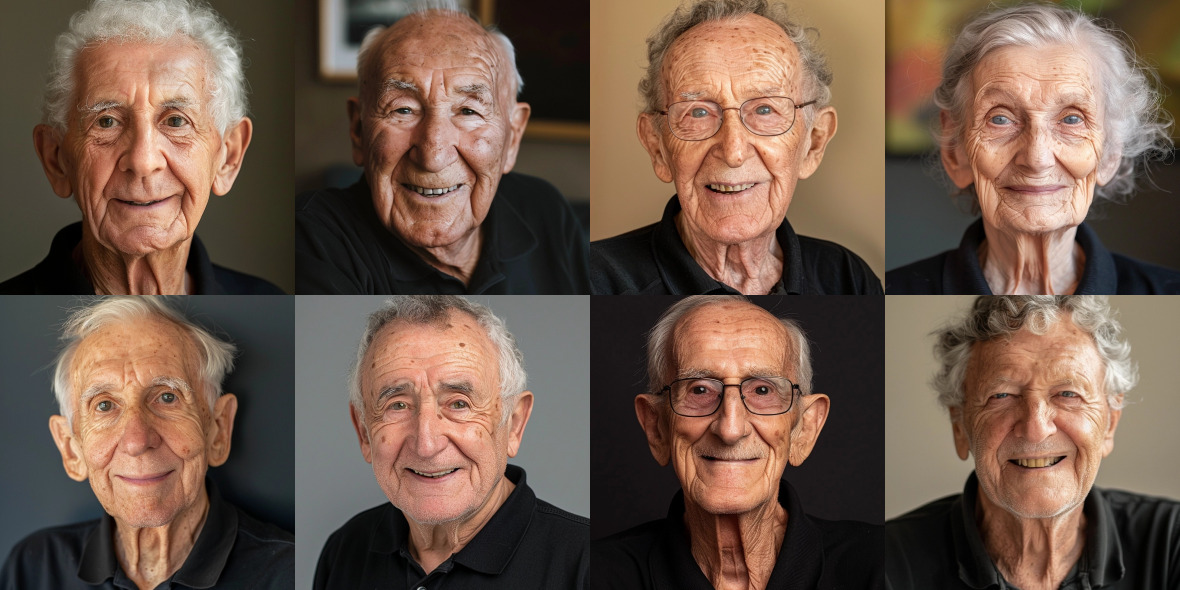Just a lot of old white men.
Is AI echoing society’s age bias?
From workplace ageism to marketing’s stereotypical depictions, the over 50s wrestle with all manner of disadvantage and misrepresentation. Brands have a huge opportunity to break the mould and connect better with this diverse, big-spending cohort.
But how deep does the bias go?
One way to peep behind the curtain is to ask AI what it thinks older audiences look like.
Our prompt was simple and open. We asked a popular generative AI tool for ‘a colour photograph of an average 50, 60, 70 and 80 year old person, face on view, smiling, wearing a black polo shirt’.
The 50+ community, AI would have us believe, is composed almost exclusively of white males.
Out of 44 images generated, only 4 were women. Only 2 could be considered ethnically diverse.
When we prompted specifically for women, diversity vanished entirely.
Tellingly, there was no nuance to AI’s view of the audiences. AI almost entirely failed to give up pictures of people who had anything but grey hair. Subjectively, they looked ‘old’, with a few exceptions of clichéd ‘silver foxes’ (invariably male).
These two rows show images derived from age prompts 20 years apart. So unrepresentative are the depictions, it’s not easy to tell which are the 60 years olds and which, the 80s.
60 year olds are often engaged members of the workforce, active, social, empowered. AI simply doesn’t seem to recognise 60+ers or how diverse they are. Left to its own devices, its algorithms seem to misjudge some prompts by at least a decade.
Is AI reflecting a wider societal tendency to view modern 60+ers as ‘old’ in the broadest sense of the word?
When our prompts focused on the over 50s, things got worse.
50-year-olds may be business leaders, adventurous travellers, big users and consumers of technology, party people. The images our AI prompts generated feel a full generation older that what most of us would consider the average 50-year-old to be.
Eminem is over 50.
AI is only as good as its trainers and its training. Perhaps we should be frustrated but not surprised that the majority of the material generated is skewed in the ways it is.
Might we also have guessed that it would be generationally biased, an unpleasant sense that it has learned that anyone over 50 is elderly?
Those of us who are members of the demographics we’re exploring here know that media and marketing representations of us miss the mark. We see the gently bland old friends awkwardly discussing insurance. We see skydiving grannies. We rarely see ourselves.
Time to make a shift
As an industry, we can take a stand and try harder to represent older age groups in the communications we create, but swaying the algorithm will take time. In the meantime, we should be healthily suspicious of generative AI’s responses to our prompts, and we must get smarter with our prompting.
At Anything But Grey, we are evangelical about correcting age bias, both because it’s wrong and because brands have so much to gain from connecting with the over 50 better.
The tendency to see the 50+ audience as a single homogenous group has to end. We believe the path to enlightenment is to reject assumptions and to fully engage the audience, actively involve them in the conception and testing of comms.
It’s why we’ve created our own audience panel and an offer called 50/50 Vision - a unique tool designed to stress-test and optimise marcomms whose audience is, or includes, the over 50s.


